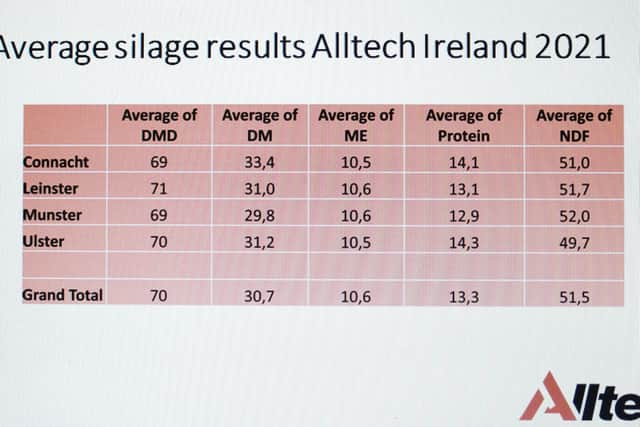Silage protein and ME values at worryingly low levels - survey
and live on Freeview channel 276
Results available from across Ireland indicate that Dry Matter Digestibility (DMD) levels are averaging at 70%, ranging from 69% to 71%. Forage dry matter levels are averaging at 30.7%.
But, undoubtedly, the most concerning results obtained relate to forage protein and metabolisable energy (ME) values. Protein percentages are averaging at 13.3%, while MEs are averaging at 10.6/kgDM.
Advertisement
Advertisement
The implications of the survey results were discussed in detail at the recent ‘Making Silage Sense’ webinar hosted by Alltech. Minimising losses at feedout was the focus of the event, which was addressed by the renowned forage specialist Dr. Dave Davies.


“Feed out losses can be extremely costly,” Dr. Davies commented.“I am also aware that clamp slippage is a major issue in Ireland this year.”
According to Davies, even when silage clamp management is at extremely high levels, there will always be a 10% nutrient loss between filed and feed out.
Feed out losses are caused by aerobic organisms. And in grass silages, it is yeasts and moulds that are most important.
Advertisement
Advertisement
“Moulds have the potential to produce mycotoxins,” Dr.Davies explained.“But they will also act to reduce forage quality.
“There will also be variability in forage quality across a clamp face.”
He added that this can relate to crop density, plus ME and protein values.
“So, for farmers feeding forage on the basis of what’s contained within a silage grab, the nutritional value of the feed offered to stock can vary on an almost daily basis,” Dr. Davies said. “So, knowing the variability in a silage clamp is very important; this information allows for the management of a clamp to be undertaken in ways that minimise these differences.”
Advertisement
Advertisement
Dr.Davies went on to point out that top waste is a key feature of silage clamps in high rainfall areas.
“This top waste must be removed as otherwise, the toxins contained within can seep down to the better-quality forage that is located below it,” he continued. “The best way to protect the silage throughout a clamp is to leave the top sheet as near to the face as possible.”
Commenting on the challenge of clamp slippage, Dr Davies commented:“Rapid filling and compacting of 15cm layers in the silo will deliver the highest levels of consolidation. In turn, this will encourage lactic acid fermentation, leading to a fast drop in pH within the clamp. Chop length for a 32% dry matter silage should be in the region of 2.5cm.”
He also added that differential consolidation levels within the silo would lead to slippage problems.
Advertisement
Advertisement
“Ensuring that the silo is consistently compacted on the basis of a 15cm grass layer depth is critically important in this regard, Dr. Davies said. “In addition, clamp packing angles should never exceed 20 degrees.”